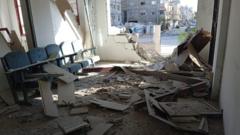Amidst the destruction from Israel's military actions in Gaza, an alarming environmental threat has emerged in the form of asbestos contamination, with experts warning of the long-term health risks associated with exposure. From respiratory illnesses to deadly cancers, the fallout from this crisis could unfold over decades.
"Asbestos Crisis Unveiled in Gaza's Rubble: A Hidden Health Disaster"

"Asbestos Crisis Unveiled in Gaza's Rubble: A Hidden Health Disaster"
The ongoing conflict in Gaza has exacerbated the presence of hazardous asbestos, posing severe health risks that may linger for generations.
Gaza's once-bustling urban areas have been transformed into ruins, but alongside the visible devastation lies a grave health threat that many survivors may not recognize: asbestos. This material, now banned in numerous countries due to its toxic properties, was widely utilized in construction and roofing, particularly in the eight urban refugee camps that house those displaced since the 1948-49 Arab-Israeli conflict. The United Nations Environment Programme (UNEP) has identified that an alarming 2.3 million tons of rubble in Gaza might be laced with asbestos, categorized as a silent killer that releases toxic fibers when disturbed.
Professor Bill Cookson from the National Centre for Mesothelioma Research has emphasized the dire situation in Gaza, labeling the debris as a "very, very toxic environment." The repercussions of exposure to these microscopic fibers, which can take decades to manifest as severe health issues such as asbestosis and mesothelioma, are a major concern among health experts. "Even small inhalations of asbestos fiber can cause subsequent mesothelioma," cautions Cookson.
The densely populated region, housing over 2.1 million people in approximately 365 square kilometers, complicates the situation further. Dust inhalation risks are heightened in Gaza due to the immediate dangers posed by military offensives, overshadowing the long-term risks of asbestos exposure. Chiara Lodi, from the NGO Médecins Sans Frontières, noted that people in Gaza are primarily focused on survival rather than the invisible threats of asbestos.
A UN survey following the 2009 conflict revealed the presence of asbestos in the debris of older structures, underlining the importance of addressing this issue carefully as reconstruction efforts proceed. However, the process of clearing the debris might exacerbate asbestos exposure risks, according to UNEP representatives, who estimated that it could take up to 21 years and $1.2 billion to manage the large-scale removal without further contamination.
The implications of asbestos exposure are compounded by the ongoing violence; with over 53,000 deaths reported as a result of the current conflict, health experts worry that the impacts of asbestos-related diseases could ultimately surpass those from the bombs. As the world reflects on Gaza's devastating conflict, understanding and addressing this hidden health crisis will be crucial for the future of its recovering population.
Professor Bill Cookson from the National Centre for Mesothelioma Research has emphasized the dire situation in Gaza, labeling the debris as a "very, very toxic environment." The repercussions of exposure to these microscopic fibers, which can take decades to manifest as severe health issues such as asbestosis and mesothelioma, are a major concern among health experts. "Even small inhalations of asbestos fiber can cause subsequent mesothelioma," cautions Cookson.
The densely populated region, housing over 2.1 million people in approximately 365 square kilometers, complicates the situation further. Dust inhalation risks are heightened in Gaza due to the immediate dangers posed by military offensives, overshadowing the long-term risks of asbestos exposure. Chiara Lodi, from the NGO Médecins Sans Frontières, noted that people in Gaza are primarily focused on survival rather than the invisible threats of asbestos.
A UN survey following the 2009 conflict revealed the presence of asbestos in the debris of older structures, underlining the importance of addressing this issue carefully as reconstruction efforts proceed. However, the process of clearing the debris might exacerbate asbestos exposure risks, according to UNEP representatives, who estimated that it could take up to 21 years and $1.2 billion to manage the large-scale removal without further contamination.
The implications of asbestos exposure are compounded by the ongoing violence; with over 53,000 deaths reported as a result of the current conflict, health experts worry that the impacts of asbestos-related diseases could ultimately surpass those from the bombs. As the world reflects on Gaza's devastating conflict, understanding and addressing this hidden health crisis will be crucial for the future of its recovering population.



















